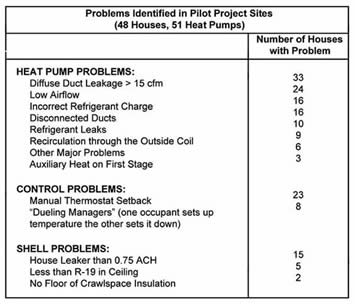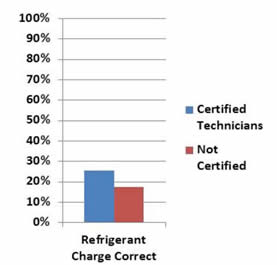Air Conditioner Performance
An air conditioner or heat pump can “blow you away” with comfort or it can keep you borderline comfortable and rob your bank account.Air conditioners and heat pumps are not just refrigerators with ducts and a fan. They are a critical component of a system that includes the building, the ducts, and the people who put the AC or HP together. |
 |
||||||||
Early Monitoring of Heat Pump HomesIn 1989 Proctor Engineering Group personnel began an investigation of “customer inquiry” (high bill complaint) customers with heat pumps in the foothills of the Sierras. That heat pump investigation revealed that the customers, along with many of their neighbors, had heat pumps that were performing at far less than their rated efficiencies. The discrepancies were many, as shown in the table below:
|
|
||||||||
The study started with a small pilot in 1990 addressing gas furnaces and air conditioners. The 1990 and 1991 study provided quality assurance through a step-by-step procedure, specialized training, form review, feedback, inspections, controls, and metering. All the management processes were closed loop processes. These methods were outgrowths of the Sun Power Furnace and Combustion Safety program. They became the basis of the CheckMe!® quality assurance system of today. Overlapping the Central Valley project was a large scale project designed to slow peak electrical load growth in the Sacramento River Delta. This project was originally planned as a low flow showerhead, CFL, water heater jacket, caulking and weatherstripping program for the residential customers. Proctor Engineering successfully lobbied to add duct sealing and blower door guided air sealing to the package of energy efficiency measures. Proctor also instituted the closed loop feedback system tested in the Central Valley project.
Is California Unique With Respect to Air Conditioner Issues? Utilities in states other than California had already instituted or were considering air conditioner tune up programs. Some of these utilities were interested in the potential for their programs. Proctor Engineering Group evaluated contractor and AC performance in a of number states including Florida, Nevada, Massachusetts, Connecticut, New Jersey, New York, Arizona, Washington, Oregon, and others. With very few exceptions for outstanding technicians, the problems found in California HVAC systems were repeated across the United States. Moving from Human Expert Systems to Human and Computer Expert Systems The quality assurance system utilized in the Sun Power furnace, duct, air sealing, and boiler programs all had one major barrier to scaling up. The barrier was the limited availability and time of the human experts that were essential to reviewing the data from the technicians and providing them feedback. This barrier continued to exist in the Sierra, Central Valley, and Delta projects. John Proctor, in consultation with some of his fellow MIT classmates, decided to produce a knowledge based expert system to duplicate portions of the human expertise. This change freed the human experts to provide information only on the difficult or troubling cases. It also made it possible for the other critical human interactions to take place between the technician and a trained computer operator that had no knowledge of the domains (Ducts, Air Sealing, Heat Pumps, Air Conditioners, Furnaces, Boilers, etc.). Beta testing of the concept produced mixed results. As engineers, the tendency was to try to diagnose for and correct any and all problems with the system, whether it was an air conditioner, furnace, or something else. This produced a protocol that was too time consuming and could not pay for itself with the achieved savings or peak reduction. Further, it was too complicated for application by most of the technicians, even with extensive training. The concept was reconfigured into a more straight-forward and effective program that concentrated on the few system problems that were widespread enough, had a significant efficiency effect, and could be diagnosed with a reasonable level of effort. The new concept rolled out as the CheckMe! Program in 1997. In the initial roll out, it was envisioned that the artificial intelligence system would reside on a computer or smaller device in the technician’s possession at the site. In the 11th hour, an option to call into a toll free line was added as a backup to the onsite system. Surprisingly, the technicians opted for the call in method for over 95% of the systems. This call in method showed unexpected benefits. All data was immediately available for analysis and reporting. The location of the technician was known and trainers could drop in on the technician at the job. Most importantly, when the technician was giving the computer operator the information, any hesitation or confusion could immediately be dealt with by a readily available expert. Since there was no delay between the work and the data download there was no loss of data. The whole system operated much faster, including payments to the contractors and follow-up mailings to the customers. Training and Certification: Solutions to AC, Heat Pump, Furnace, and House System Problems? For many years Proctor Engineering Group and others have provided training for HVAC contractors on the manufacturers’ specified methods of checking refrigerant charge, duct design and installation, measuring and setting airflow, tuning a furnace/boiler, etc. We became frustrated by the slow progress and the recidivism that occurred after the trainings. After much soul searching and analysis, we concluded that, unless there is a clear and present economic motive for adopting improved methods, things will continue with “business as usual”. It is certainly clear that a technician cannot do a job properly if they do not know how. However, we have seen too many technicians that know how to do the job properly revert to less effective, quick and dirty processes. There are many entities working on this problem. One method being tried is training coupled with certification. We were interested in whether or not certification had the desired effect on technicians’ performance. In 2006, with funding from the National Association of State Energy Offices (NASEO), Proctor Engineering did a double blind study of air conditioner installations by two groups of technicians. Both the inspectors who gathered post-installation data from the installed units and the engineers who analyzed the data were not privy to which units were completed by which technicians. One set of technicians were from contractors that were NATE certified, the other set of technicians were chosen because there was no record of them attending any of the trainings available in the area. When the results were tallied, the certified technicians were better, but by a disappointingly small margin. They still only got refrigerant charge right on one of every four new installations. The certified technicians did significantly more duct sealing, but less than 20% of the units were sealed with anything other than duct tape. Finally, the non-certified technicians obtained higher evaporator airflows than the certified technicians. Based on our experience with training, we revamped our primary training program from: “teach them everything that they need to know” to “just enough” hands-on training. “Just enough training” is based on finding the most common problems, a direct path to the diagnosis and repair, a method of verifying success and using hands-on training. This approach recognizes that the technician will not be able to deal with every situation they encounter, but they will be able to deal with the predominant situations they encounter. The “just enough” trained technician needs expert support for the unusual situations, but can be very effective and efficient. Controversy about SEER On October 17 1973, the Arab member nations of OPEC imposed an oil embargo on the U.S., while increasing prices by 70% to America’s Western European allies. After the Arab oil embargo, it was clear to citizens of the United States and even the politicians of both parties that the United States thirst for oil was a threat to our economy and our security. Prior to this time, the efficiency of air conditioners was measured using Energy Efficiency Ratio (EER), which is a continuously running efficiency at 95ºF outside. This measure is still the predominant metric internationally. Recognizing that air conditioners are almost always cycling and that cycling losses were important, DOE and NIST developed a cycling metric called Seasonal Energy Efficiency Ratio (SEER). SEER was adopted in 1979. Given the limitations of testing equipment and analysis, SEER was appropriate to the situation at that time. Over 30 years later, the current version of SEER in no longer appropriate. Not only does SEER use fictitious low values for fan watt draw and duct static pressures, but it does not distinguish between air conditioners that could perform better in wet climates and those that could perform better in dry climates. |
|||||||||


